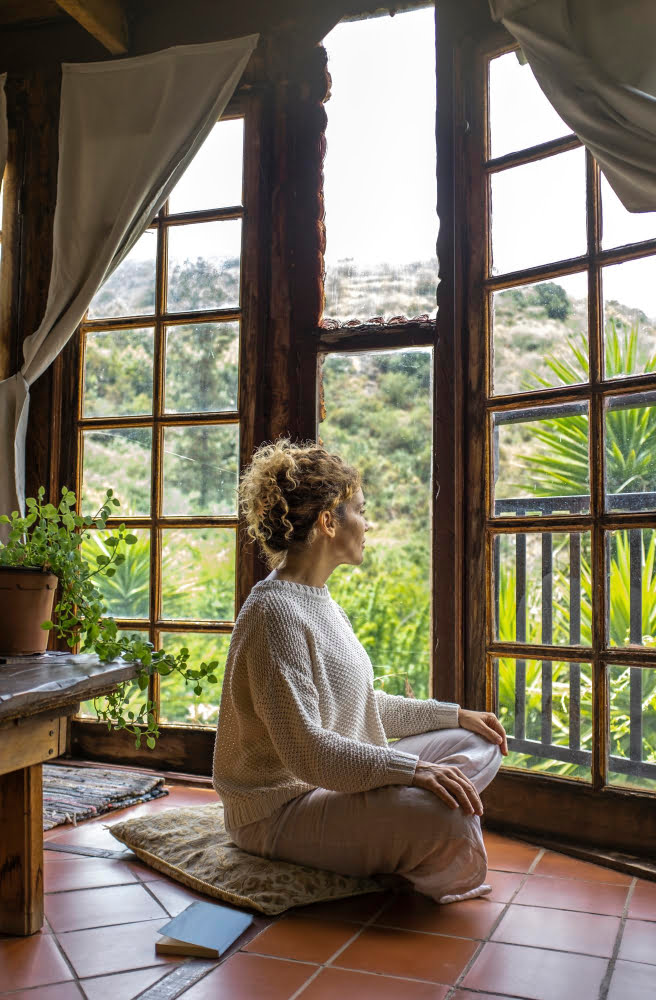Explore the profound practice of micro-meditation, because it can transform your hectic days into serene ones with just a few minutes of your time.
Micro-meditation is a mindfulness practice that involves engaging in short, focused periods of meditation throughout the day, typically lasting for one to three minutes. This technique is designed to integrate mindfulness into your everyday routine, making it a practical tool for those with busy schedules.
It can be done anywhere, anytime, and focuses on drawing your attention to the present moment, helping to reduce stress, increase focus, and promote overall well-being.
This article will delve into the specifics of micro-meditation, its benefits, and how you can incorporate it into your daily life.
Key takeaways:
- Brief duration: Micro-meditations are short bursts of meditative activity lasting a few seconds to a few minutes.
- Flexible practice: Can be done anywhere, anytime, fitting into busy schedules.
- Mindful reset: Quick moments to reduce stress and increase focus.
- Variety: Techniques include breathing, body awareness, and present moment focus.
- Increased well-being: Consistent micro-meditations lead to improved mental health.
Understanding the Concept of Micro-Meditations

Micro-meditations can be described as short bursts of meditative activity that can be incorporated throughout the day. These bite-sized pieces of mindfulness are designed to fit seamlessly into the modern busy lifestyle, making the practice of meditation more accessible and feasible.
Here are the key concepts:
- 1. Brief Duration: Unlike traditional meditation, micro-meditations are practiced for short periods – anywhere from a few seconds to a few minutes at a time.
- 2. Flexible Practice: They can be performed at any time and in any place, making them easy to incorporate even into the busiest of schedules.
- 3. Mindful Reset: The primary goal is to provide quick mindfulness moments that can reset your mental state, helping to reduce stress and increase focus.
- 4. Variety: There are various techniques you can employ, including conscious breathing, body awareness, or simply focusing your attention on the present moment.
These brief moments of mindfulness throughout the day can serve as effective ways to cultivate a more consistent mindfulness practice, fostering greater mental well-being.
Distinguishing Micro-Meditation From Traditional Meditation

Unlike the latter which often requires a quiet environment and extended periods of uninterrupted time, the former is designed to fit effortlessly into your daily routine. Here are noteworthy distinctions:
1. Duration: Regular meditation may last from 30 minutes to an hour, or more; micro-meditations typically last for a few seconds to five minutes.
2. Setting: While traditional meditation often calls for a tranquil and isolated environment, its counterpart can be performed nearly anywhere – in the middle of a busy workday, during a commute, or even when preparing meals.
3. Focus: Traditional meditation typically involves focusing on a single object, mantra, or the breath. In contrast, micro-meditation encompasses a broad variety of applications – from mindful sipping of a tea to attentive listening during a conversation.
4. Frequency: Traditional sessions might happen once or twice a day. The goal of micro-meditation is to scatter numerous sessions throughout the day for continual mindfulness.
These distinctions elucidate how these two practices differ, yet complement each other; all aiming towards a more mindful and balanced living.
Exploring the Benefits of Micro-Meditation

Micro-meditation offers several advantages that may enhance your overall well-being. Primarily, it is time-efficient, making it more accessible for those with busy lifestyles. Given the shorter duration, it can be easily integrated into your daily routine without disrupting everyday activities.
In terms of psychological benefits, micro-meditation can reduce stress levels by allowing the mind to focus on the present moment, helping to reduce the impact of distracting or distressing thoughts.
Also noteworthy is how these frequent, quick practices help increase mindfulness, effectively improving our reaction to stressors, enhancing mental clarity and promoting emotional balance. Sidebar benefits may also encompass increased creativity and better decision-making skills, quite beneficial in professional landscapes.
With regular practice, micro-meditation can contribute to an elevated mood, increased emotional resilience and overall improved mental health. Lastly, some studies indicate potential physical benefits like lowered blood pressure and improved sleep quality.
Trying Different Types of Micro-Meditations

Broadly speaking, micro-meditations can be categorised into two types: focused attention and open monitoring. Both can be easily slotted into brief moments during your daily routine.
1. Focused Attention Micro-Meditations: These require you to focus your attention on a specific object, thought, or activity. Breathing exercises make for a good example, where you divert your attention to the pattern of your breath, acknowledging its depth and rhythm.
2. Open Monitoring Micro-Meditations: These forms encourage you to note everything happening around you without reacting. This could include being aware of the sounds you hear while doing dishes, noticing the sensation of water and soap against your skin, or acknowledging the aroma of your morning coffee.
There’s also body-scan where you consciously focus on different parts of your body, from your toes to your head, noticing any tension or discomfort. Another effective micro-meditation is visualisation where you focus on a positive image or a desired outcome, helping to infuse positivity into your day.
Remember, the essence of micro-meditation lies in training your mind to dismiss distractions and maintain awareness of the present moment, even if for just a minute or two.
Implementing Micro-Meditations in Your Daily Routine

To seamlessly integrate micro-meditations into daily life, consistency and conscious attention are key. Consider starting with these straightforward steps:
- Choose Your Moments: Identify moments in the day when a pause is possible – waiting in line, during a break, or even while brushing your teeth. These moments when the mind is usually idle are perfect for a quick mindful session.
- Start Small: Begin with brief periods of about one to two minutes. Over time, as comfort with the practice grows, the duration can be extended.
- Focus on Breath: Breathing is a convenient anchor for your attention. Bringing awareness to each inhalation and exhalation can help ground you in the present moment.
- Use a Cue: A regular daily activity, like turning on the computer or getting into the car, can serve as a reminder to practice a short meditation.
- Cultivate Awareness: Practice observing thoughts and sensations without judgment. This acceptance of the present moment is at the heart of mindfulness.
- Try a Guided Method: Numerous apps and online resources offer short guided meditations for beginners. These can provide structure and guidance in the initial stages.
The notion is to make these small moments of mindfulness a regular part of the day, enhancing overall well-being and peace of mind.
Role of Micro-Meditations in Reducing Stress

Micro-meditations indeed have a crucial part in stress reduction. Here’s how:
1. Quick Relaxation: Even brief meditation sessions can help our mind relax. A few minutes alone can create a space of tranquility amidst a hectic day.
2. Enhanced Focus: These practices aim to clear the mind, thereby enhancing concentration. Over time, this enhanced focus can aid in decreasing stress levels.
3. Emotional Balance: Brief periods of mindfulness help create emotional equilibrium, leading to reduced stress reactions throughout the day.
4. Breathing Regulation: Micro-meditations often involve intentional, controlled breathing, which naturally lowers our stress response.
5. Moment Awareness: By cultivating awareness of the present, you can keep stressful thoughts about past or future events to a minimum.
Remember, micro-meditations are not a one-time solution, but a practice. Consistency is needed to experience its full benefits over time.
Frequently Practicing Micro-Meditations for Mindfulness

To integrate mindfulness into your everyday life, frequent practice of micro-meditations can be beneficial.
1. Quick Recentering: At regular intervals, pause your busy day. Close your eyes, and focus only on your breath for a few moments. Release any tension in your body.
2. Mindful Moments: Use routine activities like washing dishes or waiting for your computer to reboot as mini mindfulness sessions, paying attentively to every sensation and process.
3. Short Gratitude Exercises: Take two minutes to pen down or mentally note what you are grateful for. Gratitude has been linked to increased happiness and foster mindfulness.
4. Mindful Listening: Next time your favorite song plays, make it a point to focus on every note, every rhythm. You’re not just listening but fully engaging your awareness.
Remember, the goal is to provide your mind a tranquil break while strengthening your mindfulness muscle with these simple yet effective micro-meditations.
FAQ
What is micro mindfulness?
Micro mindfulness is a mindful practice that involves taking brief, purposeful pauses during the day to focus on the present moment, thereby reducing stress, enhancing concentration, and boosting overall well-being.
How long does it take for your brain to change from meditation?
The brain starts to show changes after approximately eight weeks of consistent daily meditation, with noted improvements in memory, emotional regulation, and mood.
What happens if you meditate everyday?
Meditating every day may reduce stress levels, improve sleep quality, and increase pain tolerance by lowering cortisol levels and fostering overall wellbeing.
What is the difference between TM and regular meditation?
Transcendental Meditation (TM) involves using a mantra to help the mind transcend the process of thought, while mindfulness meditation involves active awareness and repeatedly refocusing the mind on the present moment.
Can micro-meditation contribute towards reducing stress levels?
Yes, micro-meditation can significantly reduce stress levels by facilitating mental relaxation and promoting mindfulness.
How can mindfulness practices enhance our emotional intelligence?
Mindfulness practices enhance our emotional intelligence by enabling us to recognize and regulate our emotions, empathize with others, and respond to situations in a balanced and non-reactive manner.
What are some practical ways to incorporate micro-meditation into a daily routine?
Some practical ways to incorporate micro-meditation into a daily routine include focusing on your breath for a minute or two during a work break, practicing mindful eating during meals, and doing a short visualization exercise before bed.